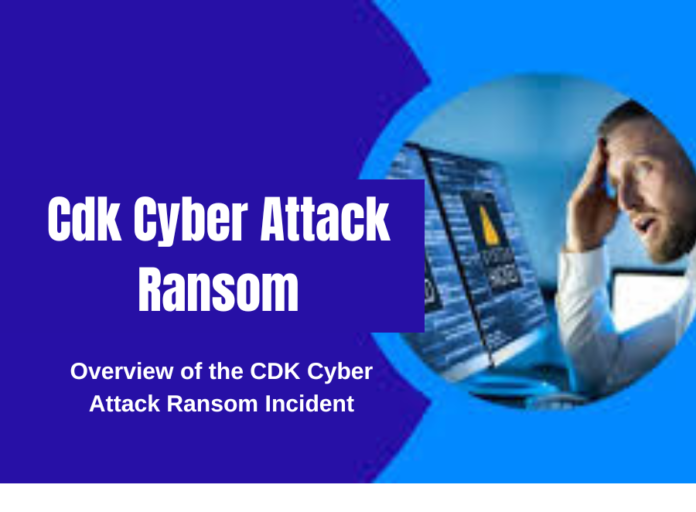In today’s digital world, cyber attacks are an ever-present threat to businesses of all sizes. The CDK cyber attack ransom incident serves as a critical reminder of this reality. With cybercriminals becoming increasingly sophisticated, understanding the implications of such attacks is essential for safeguarding sensitive information and maintaining business operations. This article highlights key learnings from the CDK cyber attack ransom situation, emphasizing the impacts on businesses, vulnerabilities exposed, and strategies to bolster cybersecurity. By examining these elements, organizations can better prepare themselves for future threats and minimize risks in an increasingly connected landscape.
Overview of the CDK Cyber Attack Ransom Incident
The CDK cyber attack ransom incident captured widespread attention for its scale and impact on the automotive industry. CDK Global, a major provider of software solutions, fell victim to a ransomware attack that compromised critical systems.The assailants encoded important information and requested a payoff for its delivery.This incident disrupted operations for many businesses relying on CDK’s services, leading to delays and potential financial losses. As the subtleties of the assault arose, obviously associations should stay watchful in safeguarding their information.Understanding what happened during this attack is crucial for developing effective prevention strategies.
The Impact on Affected Businesses
The ramifications of the CDK cyber attack ransom were significant for numerous businesses. Many dealerships and service centers experienced downtime, leading to disrupted operations and loss of revenue. The inability to access essential software hindered their ability to serve customers, impacting their reputation and bottom line. Additionally, the incident raised concerns among clients about the safety of their personal information. Businesses found themselves not only facing immediate operational challenges but also long-term trust issues with their clients. This incident underscored the need for robust contingency plans to mitigate the effects of similar attacks in the future.
Common Vulnerabilities Exposed
The CDK cyber attack highlighted several vulnerabilities that organizations need to address. One major issue was the lack of adequate security measures in place. Many businesses failed to implement up-to-date software and security patches, making them easy targets for attackers. Additionally, weak passwords and insufficient authentication processes left systems open to breaches. The incident also revealed the risks associated with third-party vendors. Many companies rely on external partners for various services, but inadequate security practices among these vendors can create openings for cybercriminals. Identifying and addressing these vulnerabilities is essential for improving overall cybersecurity.
Best Practices for Cybersecurity
To safeguard against future cyber attacks, businesses must adopt best practices in cybersecurity. Regular software updates and patch management are crucial for protecting systems from known vulnerabilities. Implementing strong password policies, such as requiring complex passwords and regular changes, can also enhance security. Organizations should conduct regular security audits to assess their defenses and identify areas for improvement. Additionally, employing multi-factor authentication adds an extra layer of protection. Fostering a complete network protection plan that incorporates these practices can fundamentally decrease the probability of succumbing to ransomware and different assaults.
Strategies for Incident Response
Having a solid incident response plan is vital for organizations facing cyber threats. A well-structured plan outlines the steps to take when an attack occurs, minimizing confusion and ensuring a swift response. . In the first place, organizations ought to lay out an episode reaction group liable for overseeing online protection occurrences. This team should conduct regular training exercises to prepare for potential attacks. Communication is also key during an incident; informing employees and clients about the situation helps maintain trust. Finally, businesses should conduct a post-incident review to analyze what went wrong and how to prevent similar issues in the future.
Importance of Employee Training and Awareness
Workers assume a basic part in keeping up with online protection inside an association. Regular training sessions can help raise awareness about potential threats, such as phishing attacks and social engineering tactics. By educating employees about safe online practices, businesses can reduce the risk of human error leading to a security breach. Additionally, fostering a culture of security encourages employees to take an active role in protecting company assets. Organizations should invest in ongoing training programs and resources to ensure that employees are equipped with the knowledge needed to identify and respond to cyber threats effectively.
Role of Technology in Prevention
Technology is an essential component of effective cybersecurity strategies. Utilizing advanced security tools can help organizations identify and neutralize threats before they escalate. Firewalls, intrusion detection systems, and antivirus software provide crucial defenses against cyber attacks. Additionally, adopting cloud solutions can enhance data security through encryption and secure backups. Organizations should also consider implementing artificial intelligence and machine learning technologies to monitor network activity and detect anomalies. By leveraging technology, businesses can create a more robust security infrastructure to protect against evolving cyber threats.
Legal and Regulatory Considerations
Cyber attacks also come with legal and regulatory implications. Organizations should figure out their commitments under information insurance regulations, for example, GDPR and CCPA, which expect them to defend individual data. Inability to consent can bring about critical fines and legitimate activities. In the wake of a cyber incident, organizations must notify affected individuals and authorities, following the regulations applicable to their industry
FAQs
1. What is a ransomware attack?
A ransomware attack is when cybercriminals encrypt a victim’s data and demand payment for its release.
2. How can businesses protect themselves from ransomware?
Businesses can protect themselves by implementing strong security measures, employee training, and regular software updates.
.3. How would it be advisable for me to respond assuming my business is gone after?
Immediately activate your incident response plan, inform your team, and seek professional help while preserving evidence.
4. Are independent companies in danger of digital assaults?
Yes, small businesses are often targets because they may have fewer resources to invest in cybersecurity.
5. How might I remain informed about network safety dangers?
Routinely follow network safety news, go to studios, and buy into industry updates to remain informed about likely dangers.




